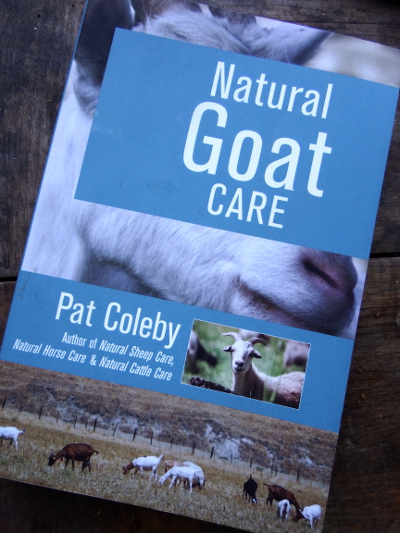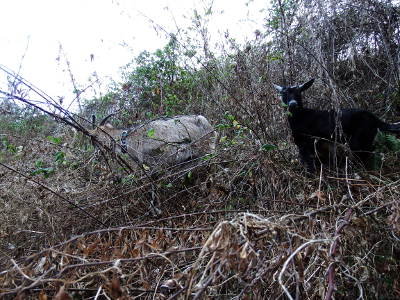
Natural Goat Care
 Back when I posted about goat books for beginners, I said that I was just starting to read Natural Goat Care
by Pat Coleby and was really enjoying it so far. Unfortunately, as I
kept turning pages, I slowly lost my faith in the author's analyses as
they relate to American farms.
Back when I posted about goat books for beginners, I said that I was just starting to read Natural Goat Care
by Pat Coleby and was really enjoying it so far. Unfortunately, as I
kept turning pages, I slowly lost my faith in the author's analyses as
they relate to American farms.
The trouble is twofold:
Coleby isn't very scientifically minded and she lives in Australia, so
the American reader needs to take all of her assertions with a major
grain of salt. For example, I suspect that Coleby is right that minerals
are essential to keeping goats healthy, but I cringe a bit when I hear
American goatkeepers using her feeding formula precisely as she lists it
in her book. Our soils are completely different from Australian soils,
which suggests that the supplements our goats need are also likely to be
quite different. Coleby pushes dolomite very hard as one of her
cure-alls, but are goats raised on browse in an area like ours with very
high magnesium in the soil likely to be deficient in magnesium?
Probably not. Similarly, she feeds a lot of grain to her goats because
Australia is so dry that it's probably close to impossible to keep goats
happy on pasture and root vegetables, but grain isn't a good choice for
most American goatkeepers. In the end, this isn't so much a fault in
the book as a fault in the lack of critical thinking on the part of her
American readers, who follow Coleby's lead blindly without assessing
their differing habitats.
 However,
the book does have its own faults. As one small example, Coleby talks
about Mendelian genetics in the chapter on breeding, and shows a clear
misunderstanding of statistics. Mendelian genetics is all about
percentages --- if you're likely to see 50% of one phenotype, that
doesn't mean that if your goat has two kids, one is definitely going to
show the phenotype and one definitely isn't. However, Coleby clearly
thinks that's the case, which throws her understanding of basic
biological principles into question.
However,
the book does have its own faults. As one small example, Coleby talks
about Mendelian genetics in the chapter on breeding, and shows a clear
misunderstanding of statistics. Mendelian genetics is all about
percentages --- if you're likely to see 50% of one phenotype, that
doesn't mean that if your goat has two kids, one is definitely going to
show the phenotype and one definitely isn't. However, Coleby clearly
thinks that's the case, which throws her understanding of basic
biological principles into question.
The trouble is that after
a few assertions that are obviously not universally true, I began to
lose faith in the author of the book. I feel that this book would have
been a much better fit for an American audience if it had come with an
introduction explaining the differences between Australian and American
goatkeeping, and if the author had made clear which of her assertions
were backed up with data and which were simply her own guesswork. As it
is, I would hesitate to recommend this book to anyone without a science
background since I suspect Coleby's regimen could do more harm than good
if followed blindly. On the other hand, if you're able to think
critically, this book will provide some food for thought and is a good
addition to your goat-keeping library.
Want more in-depth information? Browse through our books.
Or explore more posts by date or by subject.
About us: Anna Hess and Mark Hamilton spent over a decade living self-sufficiently in the mountains of Virginia before moving north to start over from scratch in the foothills of Ohio. They've experimented with permaculture, no-till gardening, trailersteading, home-based microbusinesses and much more, writing about their adventures in both blogs and books.
Want to be notified when new comments are posted on this page? Click on the RSS button after you add a comment to subscribe to the comment feed, or simply check the box beside "email replies to me" while writing your comment.

This is one of those areas that even trips up otherwise well-educated people.
If you do anything that involves analyzing data, you are basically doing statistics in one form or another, and you should educate yourself accordingly.
Unfortunately it is not taught as widely as it should be. And that makes errors such as the one you describe harder to spot for most people.